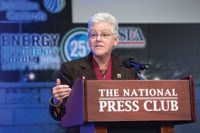In 1996, John Williams Jr. and Fred R. Burgess were both hvacr instructors at CHI Institute in Southampton, PA. Burgess also owned a contracting company. The two were out doing a job for a plastics manufacturing company that had taken over a process plant and needed to convert it from steam to a hot water boiler.
The two were carrying ladders on the roof of their van along with radiators and parts in the van. Said Williams, “We noticed that we wasted a lot of fuel and we weren’t sure if it was because of the weight or because of the stuff on top of the van.”
Intrigued by this, he said, “We experimented with putting things on top of the van and driving around.” They drove both with and without equipment on the roof and noted the gas mileage (mpg) the service van got.
Losing Mileage
With no load on a standard V8 10-ft-bed van, they registered 21 mpg. When they loaded the vehicle with two ladders and a pipe rack on the roof, mileage dropped to 15 mpg. Further tests showed an average difference of 5 to 6 mpg less with a load on the roof.Williams and Burgess then developed their idea of an air-deflective shield. The shield would be sort of a plastic nose cone attached to the front of the roof, which would provide an aerodynamic cover for the front of the ladders and other equipment secured to the roof.
A cardboard shield was put together for testing, and they noted that gas mileage only fell to 19 mpg. With an actual plastic shield and a canvas extension, “I think we can get very close to 21 mpg,” Williams said, because it will provide better aerodynamics and eliminate the drag.
Although they originally just worked on the air shield concept, they later added the canvas extension to prevent air resistance further down the ladder and get the “best fuel economy out of the vehicle that you can,” said Williams.
In addition, the extension (which includes a locking mechanism) also “protects ladders from getting weather-beaten.”
Deflectors Up
The duo applied for a patent on their design on December 31, 1997. Patent 5,996,867 for an air-deflective shield was issued on December 7, 1999.Despite the fact that they now have a patented product, Williams and Burgess have yet to find a manufacturer interested in producing their design. In fact, they are still trying to convince a firm to make a mold and produce one plastic sample to fully test it.
Knowing their market, Williams emphasized that the air shield was designed from the start to be simple and economical. They wanted, he said, “to figure out how to make this cost effective to use and inexpensive to purchase.”
Burgess now works as director of maintenance for CHI Institute in Broomall, PA. Williams currently works as a technician for Williard, Inc., Jenkintown, PA.
And the search continues for a manufacturer for their patented idea.
Publication date: 09/25/2000





